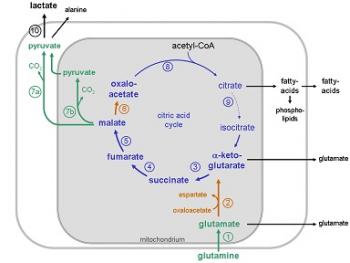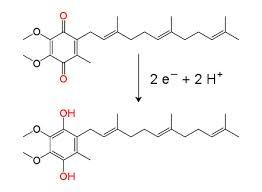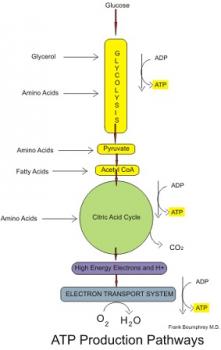Cellular respiration occurs in the mitochondria, where nutritional energy is converted to adenosine triphosphate (ATP), known as the 'energy currency' of biological systems. One molecule of ATP has three phosphate groups which are converted to adenosine diphosphate (ADP) and adenosine monophosphate (AMP) and back to ATP during the various stages. Respiration is an exothermic catabolic process, where larger units of energy at broken into smaller units for cell utilization, and additionally the process releases heat. Aerobic respiration requires the presence of oxygen, whilst anaerobic does not.
There are three main stages of cellular respiration: glycolysis, Krebs cycle and oxidative phosphorylation (electron flow). Glycolysis occurs in the cytoplasm of the cell, this is where one glucose molecule (C6H12O6) is converted to two molecules of pyruvate, and also the production of 2 ATP. The pyruvates are converted to acetyl-coenzyme A, where then it enters the Krebs cycle or the Citric acid cycle in the mitochondrial matrix. Acetyl-coenzyme A is then oxidized to produce 6 NADH, 2 FADH2 and 2 ATP in many stages, with waste products of CO2 and H2O. In the mitochondrial cristae, oxidative phosphorylation converts the remaining products to 34 ATP units by using the electron transport chain (ETC) with a proton gradient. In total, one molecule of glucose produces 38 ATP units.
Without the presence of oxygen, the two pyruvates undergo fermentation in the cell cytoplasm to produce lactic acid and carbon dioxide. Fermentation only produces 2 ATP from one glucose molecule. Fermentation is popularly known for the production of ethanol (C2H6O) in industry.
© BrainMass Inc. brainmass.com July 25, 2024, 5:41 pm ad1c9bdddf




